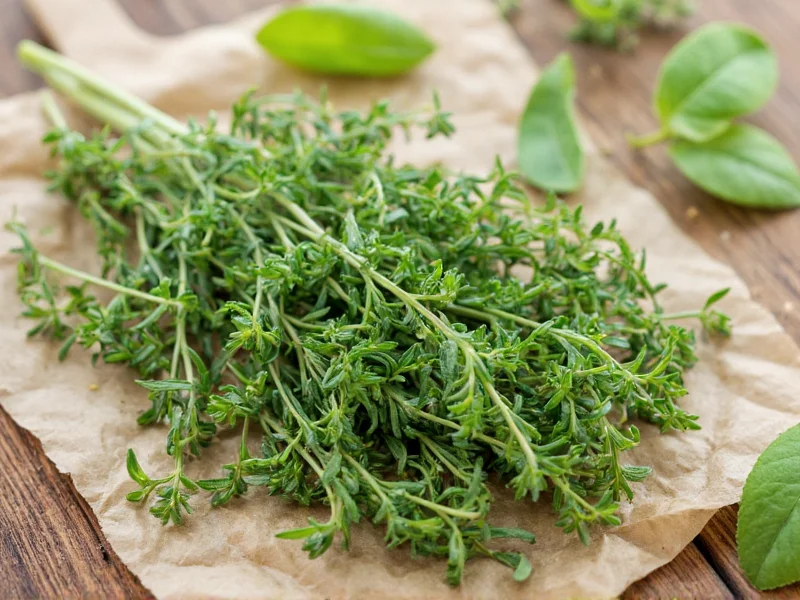Understanding Fresh Thyme: More Than Just an Herb
Thyme (Thymus vulgaris) belongs to the mint family and has been used in Mediterranean cuisine for centuries. When we talk about “fresh and thyme,” we're specifically discussing the herb in its vibrant, recently harvested state. This distinction matters because fresh thyme contains higher concentrations of volatile oils that create its distinctive aroma and flavor profile.
Why Fresh Thyme Outperforms Dried in Culinary Applications
The essential oil composition differs significantly between fresh and dried thyme. Fresh thyme contains approximately 0.5-1% essential oils by weight, while dried thyme concentrates these compounds to 1.5-2.5%. However, the drying process alters the chemical composition, reducing certain delicate flavor compounds while concentrating others.
| Characteristic | Fresh Thyme | Dried Thyme |
|---|---|---|
| Flavor Intensity | Milder, brighter notes | More concentrated, earthier |
| Best Used In | Finishing dishes, salads, delicate sauces | Long-cooked dishes, stews, braises |
| Storage Duration | 10-14 days refrigerated | 6-12 months in airtight container |
| Substitution Ratio | 1 part fresh = 3 parts dried | 1 part dried = 1/3 part fresh |
Mastering Fresh Thyme in Your Kitchen
Professional chefs recommend adding fresh thyme at specific stages depending on your desired outcome. For subtle background notes, add whole sprigs early in the cooking process and remove before serving. For pronounced herbal flavor, strip leaves from stems and add during the last 5-10 minutes of cooking. The delicate leaves lose their nuanced flavor when exposed to prolonged heat.
Optimal Storage Techniques for Maximum Freshness
Preserve fresh thyme's quality with these professional storage methods:
- Refrigerator method: Wrap stems in slightly damp paper towels and place in a perforated plastic bag
- Water method: Place stems in a glass with 1 inch of water, cover loosely with a plastic bag, and refrigerate
- Freezing method: Chop leaves, mix with olive oil, and freeze in ice cube trays for ready-to-use portions
Growing Your Own Fresh Thyme Supply
Home gardeners can maintain a continuous fresh thyme supply with minimal effort. Thyme thrives in well-draining soil with full sun exposure. Harvest by snipping 4-6 inch stems in the morning after dew evaporates but before midday heat. Regular harvesting encourages bushier growth. Container gardening works exceptionally well for thyme, making it suitable for balconies and windowsills.
Culinary Pairings That Shine with Fresh Thyme
Certain ingredients form exceptional partnerships with fresh thyme. Lemon zest creates a bright citrus-herb synergy perfect for fish and chicken dishes. Garlic and fresh thyme form the foundation of many French and Mediterranean sauces. Tomatoes benefit from thyme's earthy notes in fresh salsas and cooked sauces. For dessert applications, fresh thyme complements honey, stone fruits, and citrus in unexpected but delightful ways.
Common Fresh Thyme Mistakes to Avoid
Many home cooks make these critical errors when using fresh thyme:
- Using dried thyme measurements for fresh thyme (remember the 3:1 ratio)
- Adding fresh thyme too early in the cooking process
- Not removing tough woody stems before use
- Storing fresh thyme in airtight containers without moisture control
- Using dried thyme in dishes requiring fresh herb brightness
Health Benefits Beyond Flavor
Fresh thyme contains higher levels of thymol, carvacrol, and rosmarinic acid than its dried counterpart. These compounds provide antioxidant benefits and support respiratory health. The vitamin C content in fresh thyme exceeds that of dried thyme by approximately 30%, making it a valuable addition to immune-boosting recipes. When preparing medicinal thyme tea, fresh thyme provides more delicate flavor notes while delivering similar therapeutic compounds as dried.
Seasonal Availability and Quality Indicators
Fresh thyme reaches peak quality from late spring through early fall, though greenhouse-grown varieties remain available year-round. Select bunches with vibrant green leaves that haven't begun to yellow. Stems should feel firm, not limp or woody. Avoid packages with excessive moisture or signs of mold. When rubbed between fingers, high-quality fresh thyme releases a strong, pleasant aroma without mustiness.
How much fresh thyme equals dried thyme in recipes?
Use a 3:1 ratio when substituting fresh thyme for dried. For every tablespoon of dried thyme required, use three tablespoons of fresh thyme leaves. The reverse applies when substituting dried for fresh – use one-third the amount of dried thyme compared to fresh.
Can I freeze fresh thyme for later use?
Yes, freezing preserves fresh thyme effectively. Chop leaves, mix with olive oil, and freeze in ice cube trays. Alternatively, freeze whole sprigs in airtight containers. Frozen thyme works best in cooked dishes rather than raw applications, as texture changes after freezing.
What dishes showcase fresh thyme best?
Fresh thyme shines in dishes where its delicate flavor won't be overwhelmed: roasted vegetables, grilled fish, lemon-thyme vinaigrettes, fresh tomato salads, and finishing sauces. It's particularly effective in spring and summer dishes where bright herbal notes complement seasonal produce.
How do I properly strip thyme leaves from stems?
Hold the thyme sprig upside down by the stem tip. Using your other hand, pinch the stem near the bottom and slide your fingers upward, stripping leaves off in one motion. Discard the bare woody stem. This method works faster than picking individual leaves and minimizes leaf damage.
Does fresh thyme have different nutritional value than dried?
Fresh thyme contains higher levels of vitamin C and certain volatile compounds that diminish during drying. However, dried thyme concentrates other beneficial compounds like thymol. Both forms offer significant antioxidant benefits, but fresh thyme provides more delicate flavor notes while delivering similar therapeutic compounds.











 浙公网安备
33010002000092号
浙公网安备
33010002000092号 浙B2-20120091-4
浙B2-20120091-4